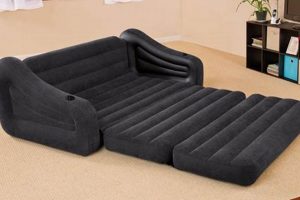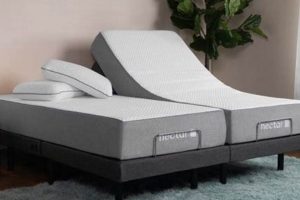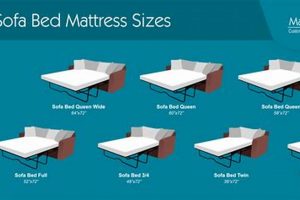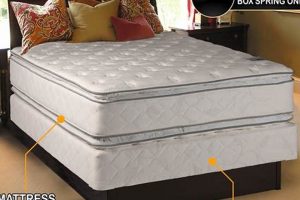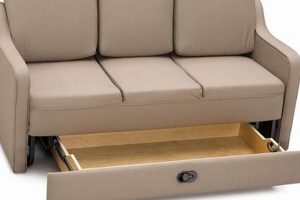An inflatable support surface designed for use on medical beds, this equipment aims to redistribute pressure and provide comfort for patients who are bedridden for extended periods. Operating on the principle of alternating inflation and deflation cycles, these systems help to minimize the risk of pressure ulcers. As an example, a patient recovering from surgery might benefit from this type of support surface to promote healing and improve overall comfort.
The use of such surfaces is crucial in healthcare settings due to their contribution to pressure injury prevention. The alternating pressure reduces constant pressure on bony prominences, thereby increasing blood circulation and minimizing tissue damage. Historically, the development of these mattresses has evolved alongside advancements in materials science and medical technology, with continuous improvements focusing on patient comfort, durability, and ease of use for healthcare providers.
The following sections will delve into the specific types of these surfaces, their operational mechanisms, maintenance considerations, and factors to consider when selecting the appropriate model for various patient needs and medical environments. Further discussion will also address cleaning protocols and preventative maintenance for prolonged use.
Hospital Bed Air Mattress
The following guidelines aim to optimize the effectiveness and longevity of inflatable support surfaces used with medical beds, ensuring patient comfort and safety.
Tip 1: Verify Proper Inflation: Ensure the support surface is inflated to the manufacturer’s specified pressure level. Insufficient inflation may render the pressure redistribution features ineffective, while overinflation may compromise patient comfort.
Tip 2: Conduct Regular Visual Inspections: Examine the surface for any signs of damage, such as tears, punctures, or leaks. Promptly address any identified issues to prevent further deterioration and potential malfunction.
Tip 3: Follow Cleaning Protocols: Adhere to the manufacturer’s recommended cleaning procedures using approved disinfectants. Proper cleaning minimizes the risk of infection and maintains the integrity of the mattress material.
Tip 4: Monitor Air Compressor Function: Regularly inspect the air compressor unit for unusual noises, vibrations, or error codes. A malfunctioning compressor can disrupt pressure regulation and compromise the therapeutic benefits of the system.
Tip 5: Ensure Proper Bed Frame Compatibility: Verify that the inflatable support surface is correctly sized and compatible with the specific medical bed frame. Incorrect fitting can lead to instability and uneven pressure distribution.
Tip 6: Implement Preventative Maintenance: Schedule routine maintenance checks, including filter replacements and hose inspections, according to the manufacturer’s guidelines. This proactive approach can extend the lifespan of the equipment and prevent costly repairs.
Tip 7: Train Staff on Proper Use: Provide comprehensive training to healthcare staff on the correct operation, maintenance, and troubleshooting procedures. Adequate training ensures consistent and effective utilization of the surface.
Adhering to these tips will contribute to optimized patient care, reduced maintenance costs, and prolonged lifespan of the pressure redistribution equipment.
The subsequent sections will provide further details on specific models and applications of the technology.
1. Pressure Redistribution
Pressure redistribution is the central functional attribute of a hospital bed air mattress. The primary cause of pressure ulcers in immobile patients is prolonged, concentrated pressure on bony prominences, leading to tissue ischemia and eventual necrosis. Air mattresses mitigate this by dynamically altering the points of contact between the patient’s body and the support surface. This constant shifting of pressure prevents any single area from bearing weight continuously, thereby maintaining adequate blood flow to the tissues. An example is seen in post-operative patients who are confined to bed for extended periods; without effective pressure redistribution, they are at high risk for developing decubitus ulcers, increasing morbidity and healthcare costs.
The importance of pressure redistribution as a component of a medical air mattress manifests in several practical applications. Air mattresses with alternating pressure capabilities sequentially inflate and deflate different sections of the mattress, creating a wave-like motion that relieves pressure from specific areas. Low air loss (LAL) systems further enhance this by allowing a small amount of air to escape through tiny perforations, reducing moisture buildup and skin maceration, both of which exacerbate pressure ulcer development. This combination of dynamic pressure relief and moisture control is crucial in managing patients with existing ulcers and preventing new ones from forming. The practical significance of understanding the mechanism of pressure redistribution lies in the ability of healthcare providers to select the most appropriate mattress for a patient’s specific needs, considering factors such as body weight, mobility level, and the presence of existing skin breakdown.
In summary, effective pressure redistribution is not merely a feature of a hospital bed air mattress, but its defining characteristic. The challenge lies in optimizing the pressure redistribution capabilities to meet the individual needs of each patient, balancing therapeutic effectiveness with patient comfort and ease of use for caregivers. A thorough understanding of the principles of pressure redistribution, along with the capabilities of different mattress designs, is essential for preventing and managing pressure ulcers in vulnerable patient populations, thus improving patient outcomes and reducing the burden on healthcare systems.
2. Alternating Inflation
Alternating inflation is a core functionality integrated within hospital bed air mattresses designed to mitigate the risks associated with prolonged immobility. This process involves the cyclical inflation and deflation of air cells within the mattress, causing a continuous shift in pressure points on the patient’s body. The intended outcome is the prevention of sustained pressure on bony prominences, such as the sacrum, heels, and hips, thereby reducing the likelihood of pressure ulcer formation. The causal relationship is direct: prolonged, uninterrupted pressure leads to tissue ischemia, while alternating inflation actively disrupts this cycle, promoting blood flow and tissue oxygenation. A practical example is observed in patients undergoing extended recovery post-surgery; the alternating inflation feature helps to maintain skin integrity and prevent the development of decubitus ulcers, which can significantly complicate the healing pr
ocess. The importance of alternating inflation lies in its proactive approach to pressure injury prevention, shifting focus from reactive treatment to preemptive care.
The practical application of alternating inflation extends beyond simple pressure relief. The cycling of air cells can be programmed to suit individual patient needs, with varying inflation and deflation durations. More advanced systems incorporate sensors that detect the patient’s weight distribution and automatically adjust the pressure in each cell accordingly, ensuring optimal pressure redistribution. Furthermore, the inclusion of low air loss technology, which allows a small amount of air to escape through the mattress surface, assists in moisture management, further reducing the risk of skin breakdown. Consider a paraplegic patient confined to a medical bed; the combination of alternating inflation and low air loss can significantly improve their quality of life by minimizing the risk of pressure sores and related complications, requiring fewer hospitalizations and reducing long-term healthcare costs.
In summary, alternating inflation is not merely a feature of a hospital bed air mattress but rather an integral component of its therapeutic function. The continuous shifting of pressure provided by this technology is a critical factor in preventing pressure ulcers and improving patient outcomes. Challenges remain in optimizing the algorithms and sensor technologies to provide personalized pressure relief, accommodating variations in patient weight, body shape, and medical condition. Nevertheless, the implementation of alternating inflation represents a significant advancement in medical bed technology, contributing to improved patient comfort, reduced healthcare costs, and enhanced overall quality of care.
3. Material Durability
The longevity and effectiveness of a hospital bed air mattress are inextricably linked to its material durability. The materials used in construction directly determine the mattress’s ability to withstand constant use, cleaning processes, and the weight of patients. Inferior materials are susceptible to tearing, punctures, and degradation from disinfectants, leading to air leaks and a loss of pressure redistribution capabilities. This, in turn, compromises patient care and increases the risk of pressure ulcers. For instance, a mattress made with thin, low-grade PVC may quickly develop leaks under the weight of a bariatric patient, rendering the alternating pressure function ineffective and negating the intended therapeutic benefit. The importance of material durability is therefore paramount in ensuring the device fulfills its intended purpose consistently and reliably.
Practical applications of durable materials extend beyond simply preventing damage. High-quality materials, such as reinforced nylon or coated polyurethane, offer enhanced resistance to microbial growth, reducing the risk of infection transmission. Furthermore, they often possess greater flexibility and conformability, improving patient comfort and minimizing shear forces on the skin. An example of this is seen in long-term care facilities, where mattresses are subjected to frequent cleaning and high patient turnover. Durable materials reduce the need for frequent replacements, lowering costs and minimizing disruption to patient care. Moreover, the choice of durable materials can also impact the mattress’s ability to withstand the repeated inflation and deflation cycles of alternating pressure systems, ensuring consistent performance over time.
In summary, material durability is a critical attribute of hospital bed air mattresses, directly influencing patient outcomes, cost-effectiveness, and infection control. Challenges remain in balancing durability with patient comfort and affordability, requiring ongoing research and innovation in materials science. A thorough understanding of the properties and limitations of different materials is essential for healthcare providers when selecting appropriate mattresses for their patient populations, ensuring optimal therapeutic efficacy and long-term value.
4. Cleaning Protocols
The rigorous maintenance of hygiene standards is essential for hospital bed air mattresses, directly impacting patient safety and infection control. Standardized cleaning protocols are not merely recommended; they are critical for preventing the spread of healthcare-associated infections (HAIs) and ensuring the longevity of the medical equipment. Improper cleaning can lead to the accumulation of pathogens, compromising the health of vulnerable patients and potentially damaging the mattress material.
- Disinfectant Selection
The choice of disinfectant is paramount. Cleaning agents must possess broad-spectrum antimicrobial activity to eliminate bacteria, viruses, and fungi effectively. However, disinfectants must also be compatible with the mattress material to prevent degradation or damage. For instance, harsh chemicals can cause PVC to crack or become brittle, leading to air leaks and rendering the mattress unusable. Healthcare facilities must adhere to manufacturer guidelines and select disinfectants approved for use on specific mattress types.
- Frequency of Cleaning
Established protocols dictate the frequency of cleaning based on usage and potential exposure. Mattresses should be thoroughly cleaned and disinfected between each patient use, regardless of the previous patient’s infection status. Additionally, routine cleaning should be performed on a scheduled basis, such as weekly or bi-weekly, even when the mattress is not actively in use. This proactive approach minimizes the risk of pathogen colonization and ensures a consistently hygienic surface.
- Cleaning Procedures
Standardized procedures outline the specific steps for effective cleaning. These procedures typically involve removing any visible debris, applying the chosen disinfectant according to the manufacturer’s instructions (including appropriate dwell time), and thoroughly drying the surface before reuse. Failure to adhere to these steps can result in incomplete disinfection, leaving behind residual pathogens. For example, failing to allow sufficient dwell time for a disinfectant may not effectively kill resistant microorganisms, such as Clostridium difficile spores.
- Documentation and Training
Comprehensive documentation of cleaning protocols and staff training are essential components. Records should be maintained to track cleaning schedules and disinfectant usage, providing evidence of compliance with hygiene standards. Furthermore, healthcare staff must receive adequate training on proper cleaning techniques and the importance of adherence to protocols. This ensures consistency in cleaning practices and minimizes the risk of human error. Without proper training, even the most effective disinfectant will be rendered useless.
In conclusion, cleaning protocols represent a critical aspect of hospital bed air mattress management, directly influencing patient safety and infection prevention. The selection of appropriate disinfectants, adherence to cleaning frequency schedules, meticulous execution of cleaning procedures, and comprehensive documentation and training are all vital components of a robust hygiene program. A failure in any one of these areas can compromise the effectiveness of the entire system, increasing the risk of HAIs and undermining the ther
apeutic benefits of the air mattress itself.
5. Compressor Reliability
The functionality of a hospital bed air mattress is fundamentally dependent on the reliability of its air compressor. The compressor is the engine that drives the system, providing the regulated airflow necessary for pressure redistribution and low air loss therapy. A malfunctioning compressor can render the mattress ineffective, negating its therapeutic benefits and potentially increasing the risk of pressure injuries. For example, if the compressor fails to maintain consistent air pressure, the alternating inflation and deflation cycles will be disrupted, leading to prolonged pressure on vulnerable areas. The importance of compressor reliability lies in its direct impact on patient outcomes and the overall efficacy of the pressure ulcer prevention strategy.
Practical applications of a reliable compressor include consistent therapeutic performance and reduced maintenance costs. A robust compressor will maintain stable air pressure, ensuring that the pressure redistribution features operate as intended, even under varying patient weights and bed positions. Furthermore, a durable compressor will require less frequent repairs and replacements, minimizing downtime and associated expenses for healthcare facilities. Consider a scenario where a critical care patient is relying on an air mattress for pressure relief. If the compressor fails unexpectedly, the patient may experience discomfort and an increased risk of skin breakdown, potentially leading to a pressure ulcer and prolonged hospital stay. The availability of a reliable compressor with built-in backup systems can mitigate such risks.
In summary, compressor reliability is not merely a desirable feature but an essential requirement for hospital bed air mattresses. The ability of the compressor to consistently deliver regulated airflow is critical for maintaining pressure redistribution, preventing pressure injuries, and ensuring patient comfort. Challenges remain in developing compressors that are both reliable and energy-efficient, while also minimizing noise levels to promote a restful environment for patients. A thorough understanding of compressor technology, along with the implementation of preventative maintenance programs, is essential for healthcare facilities to ensure the optimal performance and longevity of their air mattress systems, ultimately improving patient care and reducing healthcare costs.
6. Weight Capacity
Weight capacity is a critical specification of a hospital bed air mattress, directly influencing its safe and effective operation. Exceeding the stated weight limit can compromise the mattress’s structural integrity, leading to uneven pressure distribution and potential mattress failure. This, in turn, can negate the therapeutic benefits intended for the patient and increase the risk of pressure injuries. For example, a mattress designed for a maximum weight of 300 pounds will not adequately support a patient weighing 400 pounds, resulting in bottoming out and concentrated pressure on bony prominences. The importance of weight capacity as a component lies in its role in ensuring the mattress functions as designed, providing uniform support and pressure relief within its operational parameters. Understanding the appropriate weight limit for a specific mattress model is therefore of paramount importance to both patient safety and clinical efficacy.
The practical implications of weight capacity extend to patient selection and long-term cost considerations. Healthcare facilities must carefully assess a patient’s weight prior to assigning a mattress, ensuring it falls within the specified range. Overlooking this detail can lead to premature wear and tear on the mattress, requiring more frequent replacements and increasing equipment costs. Furthermore, specialized mattresses designed for bariatric patients often incorporate reinforced materials and enhanced support systems to accommodate higher weights. These mattresses represent a significant investment, but are essential for providing adequate pressure relief and maintaining skin integrity in this patient population. Failure to use an appropriate mattress can lead to preventable complications, increasing healthcare costs and potentially jeopardizing patient outcomes.
In summary, weight capacity is not merely a technical specification but a fundamental aspect of hospital bed air mattress selection and usage. Ensuring that the mattress is appropriately sized for the patient’s weight is crucial for both safety and therapeutic effectiveness. Challenges remain in developing lightweight yet robust materials capable of accommodating a wide range of patient weights, while also maintaining affordability. However, a commitment to proper patient assessment and adherence to manufacturer guidelines will maximize the benefits of air mattresses in preventing pressure injuries and promoting positive patient outcomes.
7. Patient Comfort
Patient comfort, while often viewed as a qualitative aspect of care, represents a critical component in the therapeutic efficacy of hospital bed air mattresses. A patient’s perception of comfort directly influences their cooperation with treatment plans, their overall well-being, and ultimately, their recovery trajectory. Therefore, the design and functionality of these mattresses must prioritize not only pressure redistribution but also the sensory experience of the patient.
- Noise Level Reduction
The operational noise generated by the air compressor is a significant factor affecting patient comfort. Constant humming or whirring sounds can disrupt sleep, induce anxiety, and contribute to a negative hospital environment. Manufacturers strive to minimize noise levels through improved compressor designs and sound-dampening materials. The practical implication is that a quieter mattress promotes restful sleep, aiding in tissue repair and recovery.
- Surface Material Properties
The texture and composition of the mattress surface directly impact patient comfort. Rough or non-breathable materials can cause skin irritation, exacerbate pressure ulcers, and create an unpleasant sensory experience. Modern air mattresses utilize soft, breathable fabrics that wick away moisture and minimize friction. This enhances patient comfort by reducing the risk of skin breakdown and promoting a more pleasant tactile sensation.
- Temperature Regulation
Maintaining a comfortable skin temperature is crucial for promoting restful sleep and preventing skin maceration. Air mattresses can contribute to temperature regulation through features like low air loss, which allows for increased airflow and reduces moisture buildup. Inadequate temperature control can lead to sweating, discomfort, and an increased risk of skin breakdown. Thus, temperature regulation is a key factor in overall patient comfort.
- Customization and Adjustability
Individual patient needs and preferences vary widely. A hospital bed air mattress that allows for customization of pressure settings and inflation cycles can significantly enhance patient comfort. The ability to tailor the mattress to a patient’s specific weight, body shape, an
d medical condition ensures optimal pressure redistribution and a more personalized comfort experience. This level of adjustability promotes patient satisfaction and adherence to treatment protocols.
In conclusion, patient comfort is not a secondary consideration but an integral aspect of hospital bed air mattress design and functionality. By addressing factors such as noise levels, surface material properties, temperature regulation, and customization, manufacturers can create mattresses that not only prevent pressure ulcers but also promote a more comfortable and therapeutic healing environment for patients.
Frequently Asked Questions
The following questions address common inquiries and concerns regarding inflatable support surfaces used in medical bed settings. The information provided aims to clarify usage, maintenance, and other pertinent details.
Question 1: What is the fundamental purpose of a medical inflatable support surface?
The primary function is pressure redistribution. By cyclically altering points of contact between a patient’s body and the bed surface, these systems minimize prolonged pressure on bony prominences, reducing the risk of pressure ulcers.
Question 2: How often should a medical inflatable support surface be cleaned?
Cleaning should occur between each patient use, adhering to the manufacturer’s recommended cleaning protocols. Regular cleaning, even when the surface is not in use, is also advised to prevent pathogen accumulation.
Question 3: What factors determine the appropriate pressure setting for an inflatable support surface?
Pressure settings are determined by the patient’s weight, body composition, and medical condition. Guidelines from the mattress manufacturer should be followed to ensure appropriate pressure redistribution.
Question 4: How does low air loss technology contribute to patient care?
Low air loss technology allows a small amount of air to escape through perforations in the mattress surface, reducing moisture buildup and promoting air circulation, thereby minimizing skin maceration.
Question 5: What are the potential consequences of exceeding the weight capacity of a medical inflatable support surface?
Exceeding the weight capacity can compromise the mattress’s structural integrity, leading to uneven pressure distribution and potential mattress failure. This can negate therapeutic benefits and increase the risk of pressure injuries.
Question 6: How can the lifespan of an inflatable support surface be maximized?
Lifespan can be extended through regular inspections, adherence to cleaning protocols, proper inflation practices, and preventative maintenance, including filter replacements and hose inspections.
These FAQs provide a foundational understanding of medical inflatable support surfaces and underscore the importance of proper usage and maintenance. Compliance with these guidelines contributes to improved patient outcomes and cost-effective healthcare practices.
The subsequent section will transition to advanced techniques.
Conclusion
This exploration of the hospital bed air mattress has underscored its critical role in modern healthcare. The technology is integral to pressure ulcer prevention, patient comfort, and overall therapeutic outcomes. Understanding the nuances of its operation, maintenance, and appropriate application is paramount for healthcare providers.
Moving forward, continued research and development are necessary to optimize the design and functionality of this technology. Healthcare facilities must prioritize staff training and adherence to best practices to maximize the benefits of the hospital bed air mattress and ensure the well-being of patients requiring prolonged bed rest. Its effective implementation remains a cornerstone of quality patient care.


